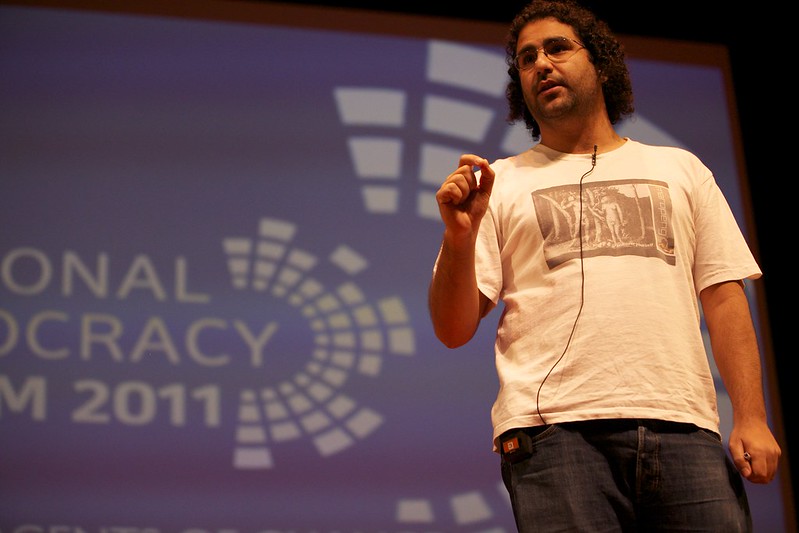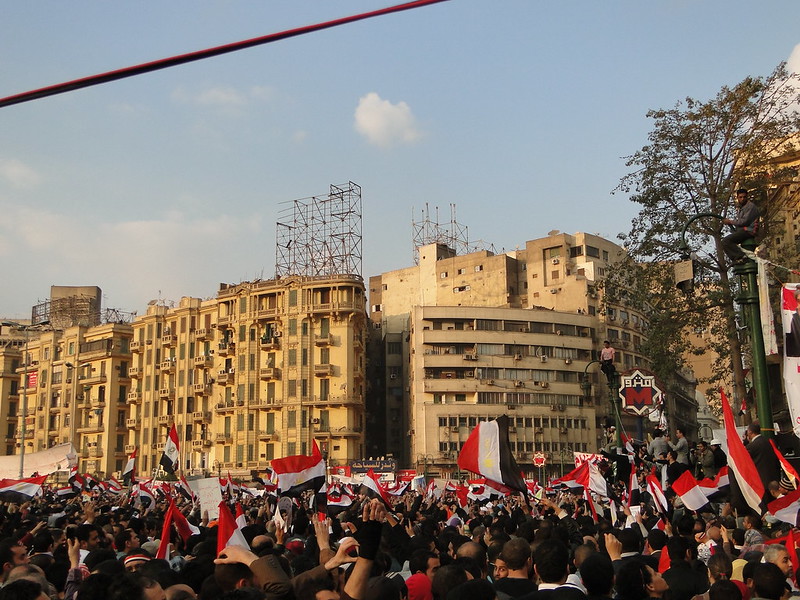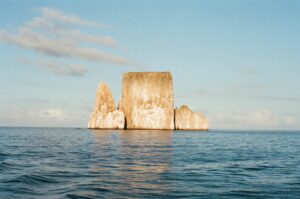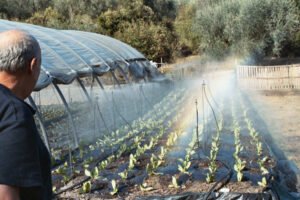eco-nnect received an invite to COP27 in early October from an organisation we collaborate with, asking us to join their delegation. Due to other commitments my colleague Isi declined the invitation, but then a week later, while talking over dinner, we touched on the upcoming Conference and I asked her why she didn’t feel to attend: “shouldn’t you be present for these kinds of conversations?” She had her mouth full of salad so she didn’t reply at first, but I could see that she was thinking. When she finished chewing she responded, “I’m not sure, I’ve never really considered us to be a part of these conversations.” She told me about the process of starting eco-nnect with Almu, how they wanted to help make living sustainably a tangible reality rather than a far away utopia through raising awareness and increasing knowledge of the environmental sector, both the issues related to climate change and the solutions that were being developed to mitigate it. I asked her “isn’t that what the focus of COP is?” To be honest, my understanding of COP — which stands for the Conference of Parties, what the United Nations Climate Change Conferences have come to be known — was limited.
I remember studying its formation during High School, how in Rio de Janeiro in 1992, the United Nations Conference on Environment and Development — otherwise known as the Rio Summit — established the United Nations Framework Convention on Climate Change (UNFCC) with the ambition of stabilising the concentration of greenhouse gasses in the Earth’s atmosphere. The COP was created as the convention’s supreme body, an association of all member states with the intention to convene regular meetings of government, NGOs and environmental experts.

COP1 took place in Berlin from March 28 to April 7 1995, and this meeting offered a vision of the tensions that would define subsequent Conferences, as debates emerged between the industrialised countries responsible for the vast proportion of emissions, and developing countries who currently suffer the worst consequences of global warming. This meeting resulted in the Berlin Mandate, a range of indefinite commitments and initiatives countries could pick and choose according to their capabilities.
COP2 was in Geneva, where the Parties accepted the findings of the second assessment of the Intergovernmental Panel on Climate Change (IPCC) — released six months earlier — while also agreeing to the need for binding targets that limit the greenhouse gas emissions of industrialised countries, which would be formalised the following year in Kyoto. It was this meeting in 1997 that led to the adoption of the Kyoto Protocol, which outlined an obligation of greenhouse gas emission reduction for 37 countries. The Protocol would be enforced in 2008 through to the end of 2012 requiring average global emissions to be cut by five percent of 1990 levels. While this was a significant moment in international climate cooperation, two of the largest emitters, China and the USA refused to ratify the agreement.
COP4 was held in November 1998 in Buenos Aires. It had been expected that unresolved issues from Kyoto would be finalised through this meeting, but finding agreement proved difficult, so the Parties adopted a Plan of Action to advance efforts to implement the Kyoto Protocol, which needed to be completed by 2000.
COP5 did not reach major conclusions.
COP6, held in Den Haag, involved a lot of disagreement — mostly around the definition of carbon sinks and how developing countries can obtain financial assistance to deal with the adverse effects of climate change — resulting in a second COP6 taking place the following year in Bonn.
Less than four months later, COP7 was held in Marrakech, where the USA observed proceedings, declining to be involved in negotiations having opted out of the Kyoto Protocol. This COP focused on the operational details for nations to ratify the Kyoto Protocol, which included the discussion of an international emissions trading scheme for those involved.
COP8 was in New Delhi and was defined by Russia’s hesitation to sign the Kyoto Protocol, which was significant as the Protocol required the involvement of countries responsible for 55% of the developed world’s 1990 carbon dioxide emissions for it to be ratified, and with both the USA and Australia refusing to be involved, Russia’s agreement was necessary.
COP9 was in Milan where the Parties finalised outstanding details from previous COPs, while COP10, in Buenos Aires, reflected on the progress made across the first 10 years of the Conference. Despite Russia still not agreeing to enact the Kyoto Protocol, the Parties discussed post-Kyoto mechanisms for the conclusion of the Protocol in 2012.
In 2005 the Kyoto Protocol was enacted, seven years after it was signed, after finally being ratified by Russia. Later that year, COP11 in Montreal was a semi-celebration for the Protocol, and the beginning of negotiations beyond its 2012 expiration.
COP12 was in Nairobi and the Parties adopted a five-year plan of procedures for an Adaptation Fund, supporting countries to build resilience and adapt to climate change.
At COP13 in Bali, an action plan was developed for a binding agreement — that would be adopted two years later at COP15 — for developed countries to cut their CO2 emissions, which also extended to China, India and Brazil, who had thus far avoided any constraints having been classified as developing nations.
At COP14 in Poznan, the focus was to refine the details of this plan ahead of COP15.
In December 2009 in Copenhagen, COP15 opened with the hope to establish a binding agreement from 2012, when the first period of the Kyoto Protocol expires. It closed with great disappointment as the resulting agreement contained no binding obligations nor concrete goals. The only passage of note, in terms of the long-term evolution of the climate negotiations of COP, was the agreement that the global temperature increase should be kept below two degrees celsius when compared to pre-industrial levels.
In its wake, Cancun’s COP16 established the Green Climate Fund, which stems from the Adaptation Fund discussed in COP12, calling for a collective commitment from the Parties of US$100 billion per annum, although this funding was not agreed upon.
The South African city of Durban hosted COP17 where the focus was again on the Kyoto Protocol beyond 2012, which resulted in an agreement for the adoption of a revised CO2 reduction treaty in 2015 to substitute and improve upon the Kyoto agreement.
This was shifted the following year at COP18 in Doha, where the 2015 ambition was extended to 2020.
COP19 in Warsaw was noteworthy for its official recognition for the need to address loss and damage, and for a mass walk-out on the last day of negotiations by the WWF, Oxfam, ActionAid, the International Trade Union Confederation, Friends of the Earth and Greenpeace who stated that “the Warsaw climate conference, which should have been an important step in the just transition to a sustainable future, is on track to deliver virtually nothing.”
COP20 in Lima saw the United States and China commit to reduce greenhouse gas emissions for the first time ever, as well as an agreed commitment to significant negotiations the following year in Paris, at COP21.
The Paris Conference in 2015 proved to be the most significant meeting and negotiations since Kyoto, with the signing of the Paris Agreement, an ambitious document that for the first time saw all Parties agree to lowering planet-warming greenhouse gas emissions regardless of whether they are developed or developing. The goal of the Agreement was to limit global warming to below two degrees celsius (but preferably to one and a half degrees) when compared to pre-industrial levels, as well as to achieve a climate neutral world by 2050.
Despite the clear steps forward, scientists felt the Paris Agreement did not cut global greenhouse gas emissions enough to avoid an increase in atmospheric temperature of two degrees celsius. Additionally, negotiations around the Green Climate (Adaptation) Fund left poorer countries disappointed. Their ambition for a legally binding provision requiring rich countries to offer a minimum of at least $100 billion a year, to help mitigate and adapt to the ravages of climate change, only appeared in the Agreement’s non-binding preamble.
As much as the Paris Agreement is heralded as a significant step in governmental climate negotiations, there were no legal requirements dictating how countries should cut their emissions, as once again the legal framework that would hold governments to clear action was put aside for future negotiations. The Agreement was again weakened by Donald Trump deciding that the USA would back out of the Paris Accord after he took office in 2017.
COP22 was held in Marrakech, with a strong focus on water, specifically around scarcity, cleanliness and sustainability. Another focus for discussions was the reduction of greenhouse emissions through low-carbon energy sources, and the growing conversation for the global financial system to shift its emphasis away from fossil fuels.
COP23 was held in Bonn and presided over by controversial Fijian Prime Minister Frank Bainimarama. Many involved were disappointed by the lack of progress toward a Loss and Damage Fund and the phasing out of coal.
COP24 was in Katowice. It was defined by the release of the IPCC’s Special Report three months earlier, which articulated what a one and a half degree warmer world would look like. The report’s bleak outlook was emphasised through a speech by 15 year old Greta Thunberg, on behalf of the global coalition Climate Justice Now!. Thunberg called out the popular politics of global governments, their continued quest for wealth and luxury, and how their lack of significant action was at the expense of their children’s futures. Thunberg concluded her speech by stating that “change is coming, whether you like it or not, the real power belongs to the people”.
The following year, this tension — between governments and corporations and “the people” — was clear when COP25, due to be held in Santiago, was moved to Madrid due to the significant protests occurring across Chile.
Then COVID happened, further limiting public protest and shifting society’s focus away from climate inaction and catastrophe. It also meant that COP26 was delayed a year, finally convening in Glasgow from October 31 to November 13 2021 with renewed hope, as Joe Biden opted the USA back into the Paris Agreement, made official through a letter sent to the United Nations on the first day of his Presidency on January 20 2021.
The agreement from COP26, the Glasgow Pact, was significant with its explicit articulation of the use of fossil fuels, through a pledge to phase out global use of coal, as well as government subsidies for oil and gas. Although a late intervention by China and India, who argued that fossil fuels were still needed for its development, the wording of “phase out” was edited to “phase down”, frustrating many of the involved Parties.
Like many agreements before it, the Glasgow Pact suggested countries come back the following year with stronger pledges to cut emissions. It also called out developed countries for failing to meet the $100 billion goal for the Green Climate Fund, urging governments to at least double finance for adaptation by 2025. On the periphery of the main negotiations, separate to the Glasgow Pact, agreements were made by governments and organisations, including more than 100 countries agreeing to cut emissions of methane by 30 percent this decade, while another saw 130 countries vowing to halt deforestation by 2030. These successes were achieved despite 503 fossil fuel lobbyists being granted access to COP26.
COP27 was hosted this November in Egypt in Sharm el-Sheikh, a holiday resort town on the southern tip of the Sinai Peninsula. Like many of the corporations sponsoring COP — the major partner Coca Cola is the world’s most significant polluter of plastic — Egypt is using its hosting role to project its environmental awareness, despite Egyptian President Abdel Fattah el-Sisi’s repressive approach to environmental groups, and Egypt’s greater population, over the past decade. This is exemplified by the treatment of Alaa Abd el-Fattah, the founder of blog aggregators Manalaa and Omraneya, who participated in nearly all demonstrations that surrounded Egypt’s January 25 Revolution in 2011, which was initially inspired by protests against police brutality and eventually led to the overthrow of then President Hosni Mubarak. In the ensuing power vacuum, the Supreme Council of the Armed Forces (SCAF) aligned with demonstrators to temporarily govern Egypt, promising to handover power to an elected President.

Public actions and protests continued as demonstrators articulated demands to the ruling SCAF, who slowly established their own agenda for the Egyptian state. In October 2011, Coptic Christian protesters gathered in front of the Maspero television building in Cairo frustrated by the SCAF’s response to the destruction of a Coptic Christian church in Aswan. The Coptic protestors called the SCAF to sack the governor of the Aswan province, and the protests gathered a crowd comparable to the numbers that gathered in Tahrir Square to overthrow Mubarak. It was amongst this crowd of people that violence broke out. Demonstrators claim they were assaulted by plain clothed attackers before clashing with members of the Egyptian Army. Rocks were thrown, gunshots were heard and tanks arrived. It was reported that at least 24 people were killed and over 300 people were injured.
Alaa Abd el-Fattah was accused of inciting violence at Maspero by assaulting soldiers and damaging military property and was arrested on October 30. Incarcerated in a cell in the Appeals Prison in Bab el-Khalq in Cairo, he wrote a letter that shares what he learned from his fellow prisoners of how and why they were imprisoned: “I spend my first two days listening to stories of torture at the hands of a police force that insists on not being reformed; that takes out its defeat on the bodies of the poor and the helpless.” Alaa appreciated the potential failure of the revolution in its pursuit of justice and lasting change. His detention was extended and a trial was held. Alaa refused to acknowledge the legitimacy of the military court trying him and refused to answer any of their questions. He remained imprisoned until December 26, when a judge representing the public prosecutor’s office ordered his release for the following day.
It was during this period that the first democratic elections in Egypt’s history were held, with influential Pan-Islamic social and religious organisation the Muslim Brotherhood’s Freedom and Justice Party, along with the Salafist Nour party claiming majority in the new Parliament. This Parliament elected the First Constituent Assembly, who would draft a new constitution, but the assembly was questioned due to its mostly Islamic members not representing the diversity of Egypt. It was subsequently suspended by the Supreme Administrative Court. This raised the stakes for the upcoming presidential election, as it meant whoever was elected held the same unregulated powers as deposed President Hosni Mubarak. The first round of the presidential election also meant the SCAF were a step closer to handing over its temporary rule.
After a law was passed by the new Parliament banning former regime figures from running for office, the Egyptian Supreme Constitutional Court — with judges appointed by Hosni Mubarak — ruled against the law, stating it was unconstitutional. The Court then decided that all laws regulating the 2011 parliamentary elections were invalid, which saw the new Parliament dissolved and the SCAF continuing as legislative authority. This was followed by military forces being stationed around the Parliament building to stop people, including lawmakers, from entering without official authorisation. The SCAF then announced a plan to issue a new interim constitution and that it would select a panel to write a permanent one.
Some suggested these events were a coup, which became more evident the following week when the SCAF issued their interim constitution giving them power to control the Prime Minister, lawmaking, the national budget and any declarations of war, while also removing the military and defence minister from Presidential authority and oversight. State news media announced the SCAF had also selected the 100 person panel that would draft a permanent constitution. This was happening alongside the second round of the presidential election, and by the time the Muslim Brotherhood’s Freedom and Justice Party’s candidate Mohamed Morsi was officially announced as President on June 24 2012, the SCAF had effectively eliminated his authority over their rule.
On June 30 Morsi was sworn in, and on July 8 he issued a decree calling the dissolved parliament back into session. This was subsequently rejected by the Supreme Constitutional Court, in the first in a series of incidents that highlighted the power struggle that would define Morsi’s presidency.
After a series of attacks along Egypt’s border with Israel, Morsi asked defence minister Mohamed Hussein Tantawi — who had acted as Egypt’s de facto head of state through the SCAF’s rule — to resign, and named Abdul Fatah al-Sisi his replacement. This came alongside a series of dismissals and appointments that overhauled Egypt’s armed forces, which Morsi, in a televised address, stated was an attempt to protect the nation. He also announced his own constitutional declaration, resembling the one issued by the SCAF, which gave him broad legislative and executive powers and a role in drafting the permanent constitution. The judicial courts intervened again, inspiring another constitutional declaration from Morsi, through which he gave himself broad powers until the constitution was agreed upon, claiming this was necessary to stop judges from thwarting the process.
Throughout this period, protests continued all over the country, including in Tahrir Square, and again Alaa Abd El-Fattah was arrested for inciting violence, although this time he was released after a few hours of questioning from authorities. The protests were often reported as clashes along the lines of those for or against Morsi, and these clashes increased as the constitution process gained momentum, facilitated by Morsi’s most recent declaration. The constitution process was still dominated by Islamists, and a group of secular figures, journalists and Coptic church representatives withdrew from the process as a result. Despite this, those that remained voted on a draft constitution and Morsi announced a referendum.
The protests continued. Judges across Egypt stopped working, delaying a ruling on the legitimacy of the constitution’s assembly. Then the judges who were due to supervise the referendum decided against doing so, and a day after that, judges amongst that group decided to support the process. Egypt was divided. The Referendum was held yet questioned, leading to more protests and more clashes, which continued and evolved until the anniversary of Mohamed Morsi’s inauguration when protestors called for him to step down. Some observers suggested not as many protestors were formally against Morsi as was reported, and that the division was overblown as the population were merely expressing their demands to the ruling elite as a whole, whether Morsi or the SCAF. (There were also suggestions, later confirmed, that some protests were funded by the Army and also the United Arab Emirates.) The Egyptian Army, and thus the SCAF announced it would align with the protestors, and the protestors welcomed this with the hope of change. The Army issued a 48-hour ultimatum for Morsi and the government to meet the demands of the Egyptian people, otherwise they would intervene. In a televised address Morsi said he honoured Egyptians’ right to protest, but the only guarantee from further violence was the constitution, which he would give his life to defend.
Tahrir Square filled with demonstrators in the lead-up to the Army’s deadline. The head of the Army, General el-Sisi led a coalition that arrested Morsi, removing him from power, while also suspending the constitution and announcing the Chief Justice of the Supreme Constitutional Court, Adly Mansour, as interim President. This was followed by the arrest of prominent figures in the Muslim Brotherhood, and then of journalists, as well as the closing of prominent media organisations, which coincided with a crackdown against public protests — with reports of open gunfire by the Army against demonstrators (although the Army denied these allegations) — including the raid of protest camps in Cairo that resulted in almost 1000 people killed. In September the interim government removed pre-trial detention limits for certain crimes allowing unconvicted dissidents to remain in indefinite detention, and then in November they issued an assembly law that effectively banned any public meeting of more than 10 people. Alongside this was the development of a new constitution, amending the draft version that led to Mohamed Morsi’s removal as President.
In November 2013, Alaa Abd El-Fattah was arrested again, facilitated by the new assembly laws, after allegedly encouraging a demonstration against the constitution outside Egypt’s Parliament. The “No to Military Trials” activist group publicly admitted to organising the protest, yet prosecutors still issued an arrest for Alaa as the event’s organiser. At first Alaa thought the arrest may have been a spectacle for the new regime to display the power of its new laws, but it became apparent the new government was more aggressive in its approach as several armed police stormed Alaa’s home, beating him and his wife and taking their phones and laptops. Soon after Alaa’s arrest, the government held a minimally attended referendum that brought their new constitution into effect, and across the first six months of 2014, General Abdel Fattah el-Sisi grew in popularity, leading him to step down from his position as the head of the Army to enable him to run for President.

It was then that Isabella interrupted the flow of our conversation: “sorry, weren’t we talking about COP?” We had been, first discussing our understanding of the meetings, then the increased public interest in negotiations since the Paris COP, and finally speaking of the decision for this year’s Conference to be held in Egypt. I expressed my cynicism of the decision, explaining how I had been following Alaa’s experiences, which led me to branch off and explain my understanding of the repressive situation that had developed in Egypt since the 2011 Revolution. “The Arab Spring gave me hope.” Isabella agreed: “Yeah, there was an energy to that time, Egypt, Occupy, a vocalised global frustration to power and the powerful, but then everything changed so quickly.”
Abdel Fattah el-Sisi became President on June 8 2014 and Egypt increasingly becomes an authoritarian state: political opposition was nullified, journalists were imprisoned, and freedom of speech was rescinded. After almost four months, Alaa was finally brought before a judge and was released from prison. He stated in an interview televised by Democracy Now that he expected to be incarcerated again. A few months later he was sentenced to a 15 year sentence for protesting and attacking a police officer at a rally against Egypt’s new assembly laws. He was tried in absentia, along with twenty-four other defendants who received the same sentence. Months later he was freed on bail, then detained, then freed again, when his case was re-trialed, and his 15 year sentence was reduced to five years with five years probation, the latter involving sleeping in a police station each night. Alaa served his prison sentence and was freed in March 2019 only to be arrested again six months later amid a widespread crackdown of anti-government protestors. He was incarcerated for the next two years until his trial, when he was finally sentenced to another five years in prison, where he currently remains. This year, Alaa has spent more than 200 days on a hunger strike to pressure Great Britain — where he holds citizenship — and the Egyptian government to let him go, and vowed to begin a water strike when COP27 began.
“It feels ridiculous COP is happening in a country with over 50,000 political prisoners, considering how important the events and demonstrations around the negotiations have become.” I was referring to the many photographs, social media posts, podcasts and YouTube videos I have engaged with from the events that surround the COP conferences. I think of Greta Thunberg at COP26 calling the Conference a “global north greenwash festival”; I think of Naomi Klein’s speech at the Climate Action Zone during COP21; I think of the Kichwa people of Sarayaku’s Canoe of Life, and the indigenous kayak flotilla along the canals of Paris. It has been since COP21 in Paris and the development of the International Indigenous Peoples Forum on Climate Change (IIPFCC) that the protests and demonstrations surrounding Conferences have increasingly been led by indigenous leaders from around the world, and when thinking of COP27, and the Egyptian assembly laws, I wonder how all of this will come together, how this Conference will play out. Isabella asks me if I want to go, “I think we can still get a press pass”, but I shake my head, “I think it’s probably better to watch this from afar.”
So I tune in from my friends’ living room in Paris, watching live streams of proceedings on YouTube. I refresh news feeds, I watch Instagram and Facebook lives, I read posts and tweets. Early talk surrounds the tumultuous year of significant shifts to political, financial and environmental systems, how societies emerged from the lockdowns and travel restrictions of the COVID pandemic faced with economic inflation that surged when Russia invaded Ukraine in February. The ensuing war inspired Europe to cut its relationship to Russian gas supplies leading to an energy crisis that has encouraged a renewed desire for cheap energy, and thus the proliferation of new fossil fuel import agreements. Despite committing to stop using coal by 2030, coal-generated electricity in Germany has risen five percent since the beginning of the war in the Ukraine; Poland has been pursuing gas deals in Senegal; Italian government ministers have travelled to Algeria, Angola, Mozambique and the Republic of Congo seeking new deals; and Britain recently announced up to 100 new domestic gas drilling licences. Add to this the tense relationship between the world’s two biggest polluters, the USA and China, and it’s easy to feel pessimistic before the negotiations have even begun. Yet tens of thousands of people turn up to be part of the spectacle and the promise for legitimate change. Along with the intense security on the ground — including x-ray machines for entire cars travelling in and out of Sharm el-Sheikh by road — delegates notice the repression of Egypt through limitations on their web usage, facilitated by the Conference’s wifi system.
Secretary-General of the United Nations António Guterres begins proceedings by reminding those present (and those watching from home) that the world’s population is about to pass eight billion people, then references an AC/DC song. Al Gore yet again talks about pollution. President of the European Commission Ursula von der Leyen asserts Europe’s leadership in supporting climate adaptation and mitigation for the global south, which supports the growing motion for a clear framework for the long discussed Loss and Damage Fund. The Indigenous Peoples Forum on Climate Change contends that carbon markets and offsets, geo-engineering, “net zero” frameworks, “nature-based solutions”, “ecosystem services” are new forms of colonisation. As the midterms in the USA are happening alongside the Conference, Nancy Pelosi uses the stage to claim that most Republicans believe that climate change is a hoax. Eighty year old President Joe Biden celebrates young people around the world as the leaders of the climate movement, while making an emission promise that will be enacted well beyond his presidency. Alaa Abd el-Fattah’s sister Sanaa Seif speaks of her brother’s situation and the need for international support, which is interrupted by Egyptians in the crowd exclaiming that she is conspiring with foreign agencies against the state of Egypt. Newly elected Brazilian President Luiz Inácio Lula da Silva tells a packed audience that combating climate change is the “highest profile of his next mandate” and vows to protect the Amazon rain forest. Indigenous-led organisation NDN Collective highlights that with 250 delegates, Indigenous peoples made up less than one percent of the 40,000 delegates at COP27, outnumbered more than two to one by fossil fuel lobbyists.
The COP concludes with the establishment of the Loss and Damage Fund, reflected by many delegates and throughout the media as the key success of this year’s meeting. Another success was President Biden and President Xi Jinping of China agreeing to reengage in climate negotiations between their countries. Time will tell whether funds are actually committed to the Loss and Damage Fund, just like whether the promise of talks between the USA and China actually evolve into significant action. Like the many COPs before this one, and like the many promises and proclamations through the Egyptian Revolution, people in power tend to say one thing and do another.
I call Isabella after the Conference’s conclusion telling her “I think we made the right decision not to attend.” I summarise the events, along the lines of the above, to which Isabella expresses her frustrations, “how is anything going to change?” It’s a good question that sparks a long conversation that reminds me of my question over dinner a few weeks ago: shouldn’t we be present for these kinds of conversations? Maybe the better question is what is the point of conversation more broadly? Sometimes it’s necessary to speak with those close to us and challenge them to see with a different perspective, or to express our concerns and let go of the anxieties we often hold within. But when this conversation becomes a yearly ritual, it makes me wonder whether the challenges are even being heard and if this cycle of Conferences is just a celebration of inaction that is creating more anxiety?
“What do you think the solution is?” I pause to reflect on her question. I hum so she knows I am still on the line. “Hmmm. Well,” I am still thinking, “I guess we need more action, and not just demand it from those in power, like it makes sense in Egypt where there was such limitations on the way the population could behave in 2011, and even more so now, but for us in the west, we have a lot of ability to create change in our personal lives and communities.” This sparks Isabella, “Totally! We should do something. Like surely we can do something?” “You and I?” I ask. “Yeah! And eco-nnect.”
Together we decide to shift focus for the website, to embody the change we feel is necessary, to engage in deeper discussions through longform articles, to profile people and organisations that inspire us, and to bridge corporate wealth and grassroots movements through consulting. This inspires one more question from Isabella, “but are we just like the COP, talking about change?” It’s an important question. “I guess we should stop talking then?” We hang up our phones to focus on the next steps.
Anton Rivette is a writer and photographer. He leads storytelling at eco-nnect.













